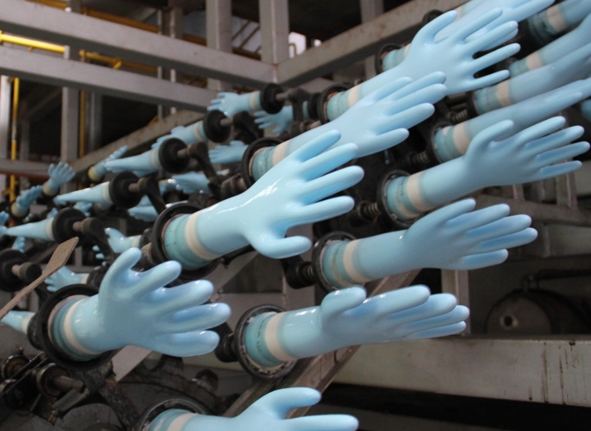And what does it take to make a good pair of work or dishwashing gloves, for example? The process starts with the raw materials. Rubber itself is an elastomer — that’s short for “elastic polymer.” Basically, this means something that can stretch and return to its original shape when released from stress. It also has chemical properties like flexibility and resistance to heat and cold weather conditions.
Rubber is derived mostly from one source material: Hevea brasiliensis (also known as Paraíba) trees in South America. Each tree produces about 1 million pounds (453 kilograms) annually, but only enough latex to meet 10 percent of global demand [sources: National Geographic; UFV]. But before harvesting any crops, farmers must clear-cut areas around their homes so they don’t disrupt the forests’ natural habitat. They use bulldozers to cut down vegetation and remove all signs of life above ground level. Afterward, they burn everything below the surface, including anything organic, such as leaves, stems and branches. This kills insects and other pests, which could carry diseases into surrounding fields and woods. Once the area is cleared, workers harvest the pods containing the rubber tree seeds using machetes. Farmers then extract the liquid inside, which turns out to be pure rubber. Workers separate the rubber by pouring it through screens into pools where water breaks open the rubbery globules, allowing them to float away individually. From there, the rubber goes on boats and trains to factories in places such as Akron, Ohio. There, machines turn the sticky goop into finished products.
While the method may seem crude at first glance, most people wouldn’t think twice if someone handed them a piece of fabric without saying much. In fact, many fabrics we wear today started off as plants, usually cotton. So how did our ancestors transform these fibrous plant fibers into cloth? Read more about this next.
Making Clothes Out Of Plants
In ancient Mesopotamia, humans used flaxseed to create linen, weaving strips together to form threads. These were later combined with wool yarn created from sheep hair. Other cultures relied heavily upon hemp, another type of grassy plant long grown by peoples across Asia and Europe since prehistoric times. Hemp was particularly popular among early Egyptian pharaohs due to its strength and durability. Today, hemp is primarily cultivated in Germany and France, while China grows 90 percent of the world’s supply of bamboo. Like cotton, both produce strong thread capable of supporting heavy loads. However, hemp and bamboo have been found in archaeological digs dating back thousands of years, suggesting they’ve played important roles in human history even longer than linen.
The earliest recorded attempt to convert plants into textiles dates back some 4,000 years ago in Ancient Egypt, although evidence suggests this practice began earlier. Around 500 BC, Egyptians discovered that soaking pieces of bark called bast fiber in hot oil would soften it up sufficiently to pull apart. While the process took several days, once the bark had soaked and dried again, it became easier to beat until flexible sheets of papyrus could finally be produced. Egyptians went on to develop new techniques over time, creating intricate designs and patterns that involved knots and braiding. By AD 400, the artisans who worked with papyrus had developed papermaking technology, transforming the thin sheets into durable documents.
Some historians believe the Chinese invented silk during the Han Dynasty, around 200 BC, after discovering mulberry worms living deep within the bark of silkworm bushes growing along riversides. Since those creatures feed exclusively on the cambium layer near the outer skin, these bushes grow quickly and provide abundant sources of soft, white silk. Silkworms themselves live underground, emerging when needed to lay eggs that will continue the cycle. To collect the worm castoffs, farmers dig tunnels under the bushes and place shallow trays filled with crushed mulberries underneath. As the larvae feast on the fruit, they excrete a substance that helps keep the tunnel clean and free of mold. When harvested, the silk comes directly from the worms themselves rather than being removed from the outside casing.
As you might expect, producing clothing from these various types of natural materials wasn’t always pleasant. Cotton requires extensive processing, starting with removing the seedpods from freshly planted cotton plants, and it needs to undergo multiple steps of bleaching and dyeing to achieve color. Linen production involves separating the lignin from cellulose, rendering it usable. For centuries, animals provided power for spinning mills, churning out yarn by hand. Then came mechanical looms powered by steam engines. Nowadays, modern textile machinery spins cotton into fine strands and combines them with other materials to create stronger fabrics. Wool isn’t spun into yarn, but instead collected from sheep naturally shed fur. Bamboo takes less effort to prepare because the tough stalks simply need boiling to remove moisture and sugars. Most other plant materials require chemicals and enzymes to break down their cellular structures. Regardless of whether the final product contains synthetic dyes or not, every step adds value to the price tag.
Whether you’re looking for quality construction or want your clothes to last awhile, read on to find out why working with natural materials often pays off.
When making shoes, leather tanneries employ a three-step process of tannage to maintain the desired look and feel of animal hides. First, the skins are boiled with different acids to loosen the collagen proteins. Next, they are scraped and rinsed thoroughly before being spread on frames. Finally, they receive regular doses of oils mixed with borax powder, forming a protective coating. Tanning agents vary widely depending on the intended purpose of the hide, ranging from milder solutions suitable for cheaper boots to highly acidic concoctions that preserve expensive high heels.
Natural Materials Make Quality Clothing
It doesn’t matter whether you prefer men’s suits, women’s dresses or children’s playwear, chances are you’ll appreciate superior craftsmanship more than anyone else. That’s because each stage of manufacturing plays a key role in ensuring the end result meets expectations. Whether you choose to buy name brand apparel or opt for locally sourced goods, know that a garment’s appearance depends largely on the skill of its creator. Here are just a few examples of how manufacturers work to ensure consumers get exactly what they pay for:
Most of us understand how wood gets turned into furniture, but few ever consider how tall palm trees become coconuts. Palm kernels begin as fruits borne by date palms, though they lack shells. During the springtime, female date palms flower, filling the air with nectar and attracting swarms of bees. Inside each small pod lies a kernel attached to a stalk, protected by fleshy pulp. Workers peel the shell off the nut with their pincers, extracting nutritious juice before eating the meat. On average, nuts mature between 18 months and two years to reach maturity.
Papaya vines bear sweet fruits year round in tropical countries such as Mexico and Hawaii. Papayas ripen into edible yellow orbs encased in firm green husks. At room temperature, the interior becomes mushy, releasing tiny black dots known as mealy bugs. If left unharmed, the bugs burrow deeper into the fruit, eventually causing it to collapse inwardly. Harvesting the ripe fruits prevents damage from occurring. Before shipping, papaya is sliced horizontally and peeled, resulting in smooth chunks perfect for salads.
After collecting sap from maple trees, sugar maples fill wooden barrels with sugary syrup. Over winter, yeast converts the sugar to alcohol, leaving behind a thick brown residue. Maize harvesters pour the mash into vats where wild yeasts consume it, converting carbohydrates into carbon dioxide gas and ethanol. Distillers refine the mixture further, filtering impurities out of the fermented sludge. Sugar refiners mix the purified solution with molasses and add glucose to increase the amount of refined starch. Refined cornstarch is sold as dextrose, maltodextrin, sorbitol or powdered fructose. Corn syrup typically contains 50 percent sucrose and 45 percent maltodextrines.
Cotton Gin Manufacturers build massive steel rollers with teeth spaced 3 inches (7 centimeters) apart, rotating slowly to tear bundles of cotton stalks into individual fibers. Water sprays stream onto the rolls to rinse and dry the filaments. A series of brushes removes debris and tangles. Weaving machine operators pass the ends of the newly separated fibers through large reels to hold them temporarily. Meanwhile, combs comb out loose bits and limit shrinkage caused by humidity. Specialized spindles move forward automatically as the operator feeds additional lengths of cotton into the loom. Loom shuttles weave the continuous web tightly, eliminating excess slack. Several sets of pins punch holes throughout the length of the woven sheet. Last, sewing machine operators stitch layers of cotton together, turning them into shirts, towels, bandages and countless other everyday items.

